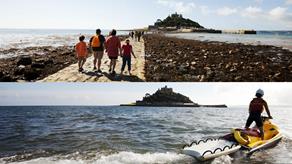
Know the risks
It's easier than you think to get into trouble in the water. Get to grips with the common risk factors and find out how to minimise them.
Know what to do
Don't end up in trouble. Here are our top safety tips for every scenario.
- Be aware of the dangers.
- Know your limits and don't take risks.
- Go with others and look out for each other.
- Make sure your phone is charged so you can call for help if you come across anyone who needs it.
Where to be: In the summer head to a lifeguarded beach, between the red and yellow flags.
Before going into the water: Do the conditions exceed your ability? Swimming in the sea is very different to swimming in a pool.
When you enter: Take a moment to acclimatise to the water temperature.
While you're in: Make sure you have someone watching from the beach to provide shore cover. Make sure they have a way to call for help.
Where to be: Keep away from the edge. Stick to designated paths. Beware of uneven, unstable or slippery ground.
What to look for: Read safety signs. Always seek local advice on the tides to make sure you don't get cut off.
Reduce the risk: Avoid walking alone or at night. Always make sure you have a way to call for help.
Keep buoyant: Fatigue can kick in quickly. Wear a suitable personal flotation device – it could save your life. See our guidance on lifejackets and buoyancy aids (PDF 3.26 MB).
Be seen: Carry a means of calling for help in case you do end up in trouble.
Have shore cover: If you are alone on the water, tell someone ashore your plans and what time you expect to be back.
Around half the people who die at the coast slip, trip or fall into the water. They never intend to get wet.
Take a minute: The initial shock of being in cold water can cause you to gasp and panic. Effects of cold water shock pass in less than a minute so don’t try to swim straight away.
Relax and float: Float on your back while you catch your breath. Try to get hold of something that will help you float.
Keep calm: Once you're calm, call for help. Swim for safety if you are able.
Call for help: Call 999 or 112. Ask for the coastguard.
Throw them a line: Have something that floats or that they can hold on to? Throw it to them.
Stay safe: Do not enter the water yourself. Too many people drown trying to save others.
Check the forecasts: Keep a keen eye on the forecasts and tides and always seek local advice in advance.
Check your surroundings: Storms can change the landscape of some beaches, changing or damaging access points, or even creating new areas for rip currents.
Beware of large waves: Even from the shore, large breaking waves can sweep you off your feet and drag you out to sea.
How can I stay safe near open water?
Where to be: when near open water, keep well away from the water’s edge. Stick to designated paths and beware of uneven, unstable or slippery ground. If you fall into the water, Float to Live.
What to look for: make sure you read any safety signs so you know of any hazards specific to the area you’re in. Check the tides and seek local advice to avoid being cut off by the tide.
Reduce the risks: avoid walking alone or at night. Always make sure you have a means of calling for help.
What should I do to reduce the risks on the water?
If you’re going on the water, whether you’re stand-up paddleboarding or kayaking, here are some tips to help you stay safe.
Keep buoyant: wear a suitable personal flotation device – if you end up in the water, fatigue can kick in quickly. A buoyancy aid could save your life.
Call for help: always carry a suitable means of calling for help in case you end up in difficulty.
Have shore cover: always tell someone on the shore your plans – where you are going and what time you expect to be back. If you’re not back, they’ll be able to raise the alarm.
What should I do if I find myself in the water unexpectedly?
Around half the people who die at the coast never intended to go in the water. If you find yourself in the water unexpectedly, you should Float to Live by following these steps:
- Tilt your head back and submerge your ears
- Relax and try to breathe normally
- Use your hands to help you stay afloat
- It's OK if your legs sink, everyone floats differently
- Spread your arms and legs to improve stability





